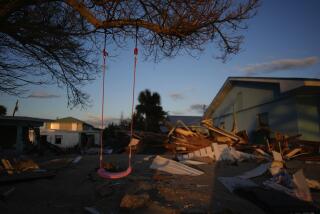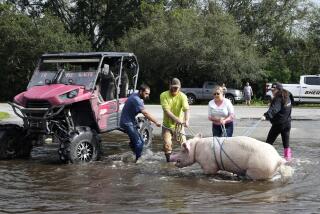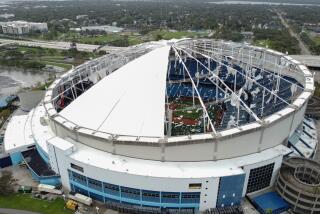Florida Digs In as It Digs Out
- Share via
WEST PALM BEACH, Fla. — Floridians battered by Hurricane Frances emerged from shuttered homes and shelters Monday to face ruined houses, felled trees and lines the length of two football fields for suddenly precious ice, batteries and gasoline.
Weakened to a tropical storm but still blowing winds of 65 mph, Frances made its second landfall Monday afternoon south of Tallahassee. It dumped as much as 10 inches of rain and knocked out power in the state’s Panhandle before winds dropped to 35 mph. Frances is headed to Georgia and Alabama.
The storm swamped the downstate peninsula over the weekend with as much as 13 inches of rain before passing over the Gulf of Mexico and aiming for the Panhandle.
Frances left damage “in the couple of billions of dollars,” according to an early estimate from state Chief Financial Officer Tom Gallagher. Last month, Hurricane Charley ravaged the southwestern coast and destroyed or damaged more than 30,000 homes; insured losses were estimated at $7.4 billion.
“There’s some individual home damage, but not a lot of total wipeout” compared with Charley, said Gallagher, who toured stricken areas Monday.
The state’s tourism industry also took a hit. Frances disrupted the typically busy Labor Day weekend, as theme parks, restaurants, souvenir shops and convention centers shut down.
But as power came back on in some communities, restaurants, grocery stores and other businesses along the Atlantic coast began to open their doors.
Airports in Fort Lauderdale, Palm Beach, St. Lucie, Vero Beach, Tampa and Orlando reopened.
At Cape Canaveral, 85 miles north of Sewall’s Point, where the hurricane came ashore early Sunday, heavy winds dislodged more than 1,000 panels from a building where spacecraft are assembled at the Kennedy Space Center. Officials said the damage could delay plans to resume shuttle launches next spring.
The storm killed nine people as it rampaged through the Bahamas and Florida, including the son-in-law and grandson of Florida State University football coach Bobby Bowden. The two were killed when their car skidded on Interstate 10 in Alachua County, in northern Florida, and struck a utility truck coming from Texas to help restore power.
Frances struck while Florida was recovering from Charley, a smaller but more powerful storm that killed 27 people last month.
As it churned across the Caribbean toward the mainland last week, Frances was a Category 4 hurricane on the five-step intensity scale, with sustained winds of 145 mph. Its winds slowed to 105 mph by the time it reached Florida, making it a Category 2 hurricane. But its slow crawl across the Bahamas and Florida allowed it to dump a tremendous amount of rain.
Frances knocked out power to 3.3 million homes and businesses, flooded neighborhoods from Palm Beach to Tampa, and peeled off roofs.
Judy and Norman Michaud moved from Maine to Ridgeway, in Martin County on the Atlantic coast, two years ago to escape the winters and ease her arthritis. On Monday, Judy, 61, cried as she toured the wreckage of her mobile home. The living room and bedroom were exposed to the sky and the furniture was soaked and covered with debris.
“I don’t want to stay in Florida, but my husband said we just have to start over,” she said.
Even those whose homes were untouched struggled to find the basics of modern life.
Florida Power and Light, the state’s biggest utility, said 1.3 million of the 2.8 million households and businesses it serves remained without power at 4 p.m. Monday. The Emergency Operations Center said it did not know how many people remained without electricity statewide.
In Palm Beach County, where 17% of homes and businesses had power by late afternoon, radio stations reported that a Wal-Mart selling ice and batteries would open at noon. By 12:15, more than 1,000 people had lined up.
At the back of the line was William Giarraputo, 57. He had waited six hours at a Home Depot to buy plywood before the storm, and was willing to wait almost as long to get ice before the food in his freezer spoiled. He had already eaten the best of it: a lobster tail he boiled on his gas stove as the storm raged. “I wanted comfort food,” he said.
Gasoline remained in short supply; stations either had no fuel or no power to pump it. Lines of cars snaked down the block at any place that looked like it may have gas. State officials said tankers were expected to deliver 125 million gallons of gas by Wednesday as ports reopen.
Looming over Floridians was the possibility that another hurricane was on its way. Ivan, a Category 2 hurricane with sustained winds of 105 mph, is swirling near the island of Barbados and could arrive near Cuba -- then Florida, perhaps -- by the end of the week, said forecasters with the National Hurricane Center.
“People are just going to leave their hurricane shutters up,” Michael Papa, a school administrator, said as he hauled broken branches and palm fronds to the curb outside his home in West Palm Beach’s Flamingo Park.
President Bush, the brother of Florida Gov. Jeb Bush, asked Congress to free up $2 billion in emergency funds to help with cleanup and relief efforts from Frances and Charley. Bush planned a Wednesday visit to Florida, a crucial swing state in his bid for reelection.
At Kennedy Space Center, Frances tore a 50-foot-wide hole and several smaller ones in the mammoth facility where NASA assembles space vehicles, officials said Monday.
The three shuttles -- Discovery, Atlantis and Endeavour, which remain grounded after the Columbia accident -- were not inside the building and were not damaged, said James W. Kennedy, space center director.
The building where protective thermal tiles for the shuttles are produced had its roof partially torn off and suffered “significant wall damage,” NASA said. Kennedy said the damage could delay the agency’s planned return to space in the spring, but that would not be known until detailed inspections scheduled to begin today.
The space center was evacuated for the storm, and no workers were injured.
With two hurricanes in a month and another threatening Florida, the state could lose its reputation as a fun summertime destination, said Abraham Pizam, dean of the Rosen College of Hospitality Management at the University of Central Florida.
While riding out the storm in an Orlando hotel, he met British tourists who said they would not come back during hurricane season. “If we get Ivan, that will be three in a row,” he said. “People will think twice before coming to Florida, especially during the hurricane season. That would be a significant loss.”
When theme parks and other businesses aimed at tourists tally their lost receipts and repair bills, the storm may well have cost them more than $1 billion, Pizam said.
Tourists generally spend about $50 billion a year in Florida, according to Tom Flanigan, a spokesman for Visit Florida, a Tallahassee commission partially funded by the state to market Florida.
Northern Florida was expected to receive heavy rain Monday night as Frances moved into Alabama and Georgia. The tropical depression could bring 6 to 10 inches of rain to parts of the Tennessee and Ohio valleys this week.
Richard Smith, director of emergency management for Leon County, which includes Tallahassee, said Frances passed quickly over the state capital, bringing winds of about 40 mph. About 12,000 utility customers lost power.
Smith said he considered the county luckier than other parts of Florida. But he has had enough.
“We’re wondering what we did wrong,” Smith said. “And we’ve still got Ivan to contend with.”
Gaither reported from Palm Beach County, Colker from Martin County. John M. Glionna in Orlando and Scott Gold in Houston contributed to this report.
More to Read
Sign up for Essential California
The most important California stories and recommendations in your inbox every morning.
You may occasionally receive promotional content from the Los Angeles Times.











